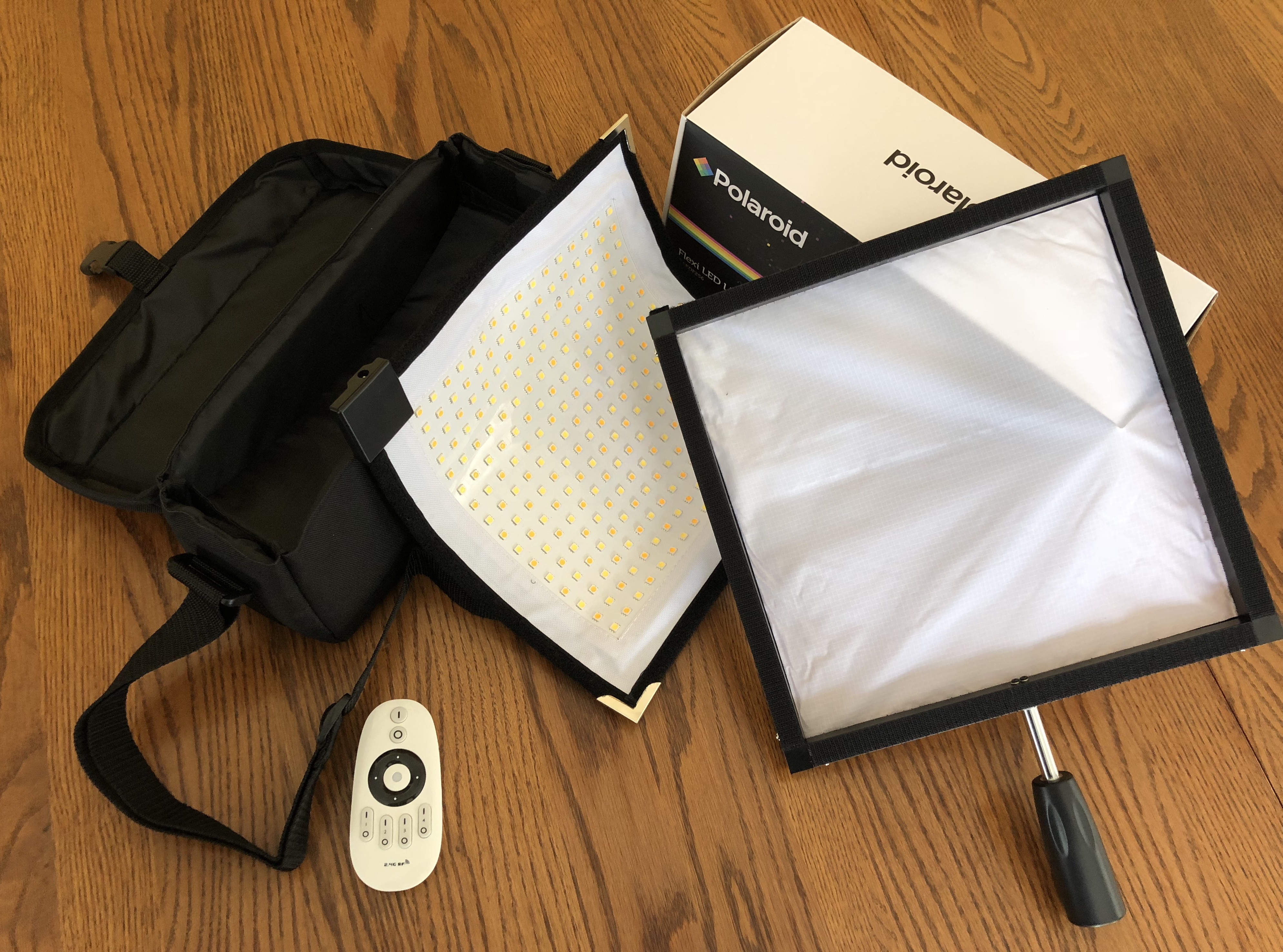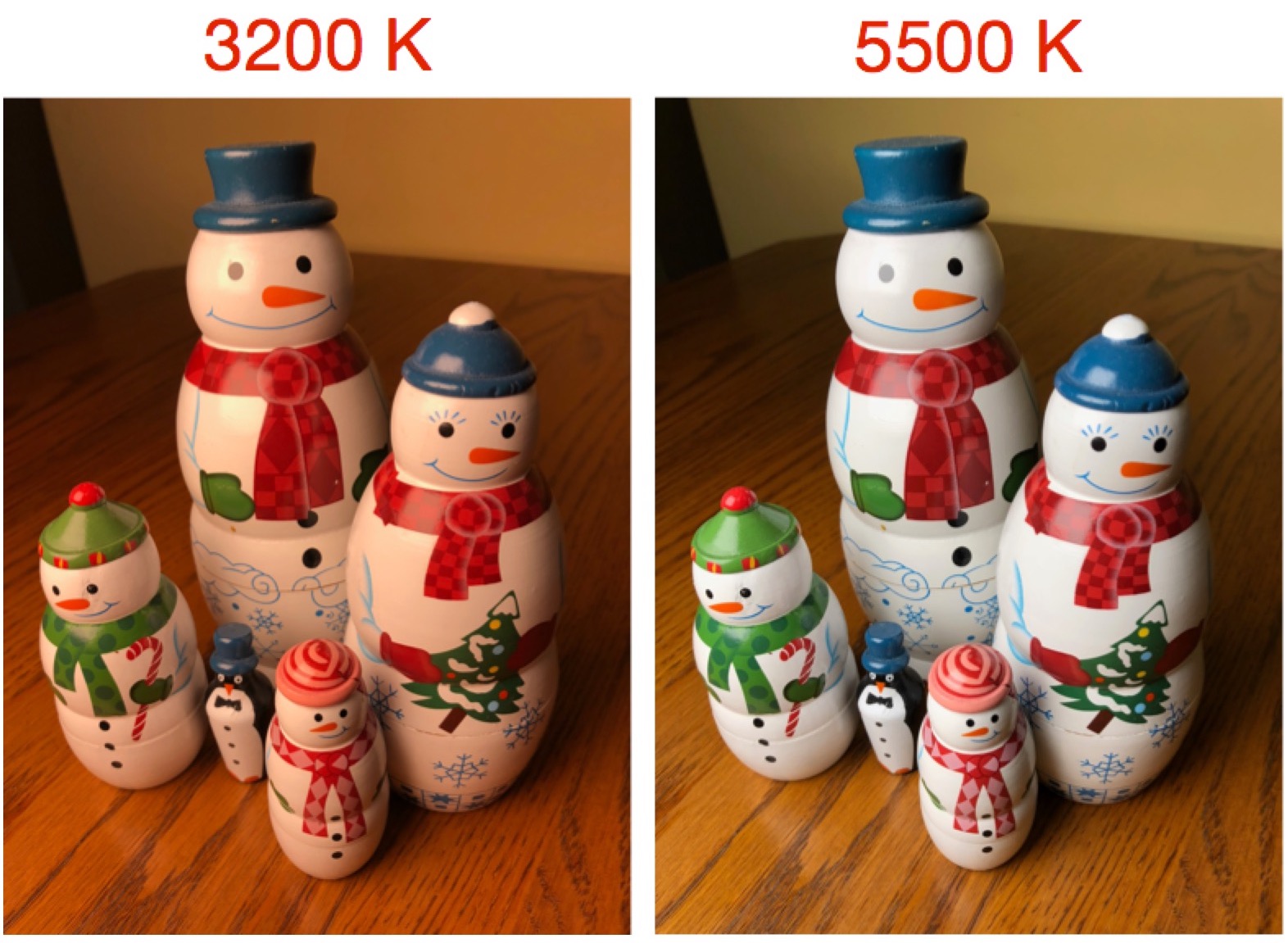Let There Be (Inexpensive, Configurable, Diffuse, Portable) Light
Being a journalist today requires being able to do much more than just write well and quickly. You also need to be an adequate photographer and be comfortable with live audio and video. Standard Apple gear — Macs and iOS devices — provides sufficient hardware for getting started, but some accoutrements can improve your output. In particular, lighting can be troublesome, since many offices aren’t well lit, which can result in dim video, overly exposed flash photos, or glaring reflections from nearby light bulbs.
Polaroid has a new product to help anyone trying to improve lighting for photography or video work: the Polaroid Flexi LED Light Panel. It’s an 11.8-inch (30 cm) flexible nylon panel with 256 bi-color LEDs wired into it in a 16-by-16 grid pattern.
Its wire edges are covered with Velcro so you can stick it to an easy-to-assemble metal frame. It comes with a similarly sized square of thin nylon cloth, also edged in Velcro, that you attach to the other side of the metal frame to act as a diffusion filter. One edge of the metal frame has a ¼-inch threaded screw hole designed for use with standard tripod mounts, or you can attach an included hand grip.
A corner of the light panel has a plastic piece that features a small round AC adapter port. The provided power adapter has one cable that plugs into the wall and another that plugs into the light panel; the latter has a power switch in the middle of it. For more control, however, you’ll use the 2.4 GHz wireless remote control, and if you set up multiple light panels, the remote can control up to four at once.
You get quite a bit of control with the remote. You can increase and decrease the brightness, with a maximum output of 4500 lumens. That’s a lot — a standard 100-watt incandescent bulb puts out about 1600 lumens. Polaroid doesn’t say what the output is on the low end, but it’s worth noting that the light doesn’t flicker when it’s dimmed all the way down.
The remote also lets you change the color temperature from 3200 K to 5500 K (that’s degrees Kelvin). 3200 K is in the relatively warm “soft white” range and provides more orange/red light, whereas 5500 K has more blue in it and is the average noon daylight color — in light bulbs, it would be referred to as “cool white” or “daylight.” The utility of being able to change the color temperature is that you can adjust for other light in the room so skin tones look the way you want.
If you’re a serious photography geek, the light panel has a CRI — color rendition index — that’s equal to or greater than 90. CRI measures a light source’s ability to render colors the same way sunlight does, and a number over 80 is considered acceptable for most indoor residential applications. A photographer friend who works in Digital Preservation at Cornell University said that he has to buy lights that have a CRI of 98 or higher for professional work. But the lights he works with cost over $1000 and
require bulky cases.
In contrast to that high-end gear, the Polaroid Flexi LED Light Panel costs about $125 and, because it’s flexible, can be broken down, rolled up, and stored in a flexible carrying case similar in shape to a family-size loaf of bread. Just don’t fold it in half.
So far, I’ve used the light panel on a tripod behind my monitors to improve the lighting when I was a guest on the MacBreak Weekly podcast and to help with some of the photography we need to do for TidBITS Content Network articles. I particularly appreciated being able to put diffuse light — adjusted to compensate for the other lights on in the room — right on my face for MacBreak Weekly, since regular bulbs are too glaring to look at. And with the photography, the big win was being able to turn off other room lights that tend to reflect badly off shiny iPhone and iPad screens.
The only downside I’ve noted is that Polaroid says nothing about powering the light panel from battery packs for use in the field. It might be possible — the light panel claims to be using 24 volts at 2 amps — but I find it surprising that Polaroid wouldn’t mention such a capability because competing LED light panels I found are quite clear about which common batteries are compatible.
Speaking of which, I found another flexible light panel that’s radically more expensive, the $679 Westcott Flex LED Kit with a 95 CRI rating, and a very similar product from Samtian that’s less expensive and supports batteries, but can’t change color temperature. And then there’s a Powerextra LED light panel that’s a bit cheaper and full-featured, but it’s smaller, heavier, and not flexible. I haven’t used any of these, but one of them might be worth checking into if you need to use batteries instead of wall
power.
My review unit of the Polaroid Flexi LED Light Panel has to go back now, but I’ll be getting my own shortly — it’s just too useful for the kind of photography and video work we’re doing more of every day.


Wow!
This is quite a bit different for Tidbits to post something so, well, non-mac-centrick.
I love it!
I'm a long time commercial photographer and have been a loyal, faithful, devoted, Tidbits reader for.... truthfully, decades. During that time I cannot recall any photography related content.
So thank you Adam for once again going to new places with Tidbits and bringing us along for the ride.
All the best in the new year!
Glad you liked it! Pretty much everything we've done in the past has been related to Mac photo software, but when the Polaroid PR people asked if I'd be interested in reviewing this light panel, it struck me as a likely win for a review, especially given how useful it could be for a variety of uses.
I have some other random hardware in the office here that I've never written about because it wasn't functional enough to waste words on.
Thanks, helpful.
I agree about the battery thing. Surely a product like this is particularly interesting in the field.
There are lots of good options for LED lighting that are less expensive. Just Check B&H for lighting. I got a DRACAST CAMLUX-PRO for $69 - and it included two batteries and a charger. It runs at full power for three or four hours on the two batteries. These LED lighting systems have revolutionized lighting. I photograph my orchids and this lighting has been great - I shoot with the lens stopped down to get depth of field and these bright lights make that easy.
David
Thanks, David! The Dracast and other less expensive light panels generally seem to have fewer LEDs (between 160 and 200, compared to the 256 in the Polaroid panel), but they don't always say how much light they put out. So I can't tell if they're entirely comparable or not.
I have two of these lights that I place on each side of my target. Helps to smooth out the light and affords the option to vary light from each side for more “dramatic” effects.
David
Sounds like two of them would total 320 - 400 LEDs or 25% - 56% increase over the Polaroid's 256. And the cost for 2 @ $69 each would only be 10% more than the Polaroid.
Looks like a no-brainer, Adam.
It's not so simple. You'd need two of everything else too, which would increase cost (buying another tripod, for instance) and using multiple lights to equal the output might not work in the space available.
My original comment was because the original article sounded to me like a product plug, and many other cost-effective options are available. UMMV.
David
It was a hands-on product review, not a plug, which is why I also pointed out things that were lacking, such as battery support, and mentioned competing options that seemed comparable in some ways. I didn't find the ones you used, but as I said, I can't tell from the specs how comparable they are.